The 9 Best Cenotes in the Yucatan

Cenotes are freshwater sinkholes found scattered across the Yucatan Peninsula in Mexico. They are among the popular tourist spots in the Yucatan, and can often be combined for great day trips including a Mayan ruin! Here is a list of the 10 cenotes (not 9 as it says in the title!) that I think are the best cenotes in the Yucatan to visit. These are the ones I enjoy bringing friends and visitors to. I love to watch the impact of the ‘Wow!’ factor.
Have you ever wondered what makes a Cenote?
Cenotes are typically formed when the roof of a cave collapses, exposing the previously hidden cavern pool to the sky.
Some are at ground level, like natural cenote swimming pools. Others are underground except for an opening in the roof of the cave, which can be large or small. A third is completely underground.
How many cenotes are in the Yucatan Peninsula? According to most reports, the Yucatan Peninsula has from 6,000 to 10,000, with more discovered almost daily (as work on the Mayan train cuts through the Yucatan jungle and biosphere).
The following is a selection of what in my view are the best cenotes in the Yucatan. This is not a full list by far. These cenotes are either normally not crowded or they possess a unique charm that makes putting up with crowds acceptable. Or both.
If you want to learn more about Cenotes in the Yucatan, how they were formed, the different types, how the Cenotes are linked to the extinction of the dinosaurs – What is a Cenote?
Table of Contents
Where are the best Cenotes?
That’s a difficult question to answer. Other than the best cenotes are in the Yucatan Peninsula!
With over 6,000 cenotes (and possibly even more than 10,000 cenotes), the variation is immense.
Five factors typically influence what makes someone call it ‘the best’ cenote:
- The type of cenote
- The location of the cenote
- How crowded the cenote is
- The facilities on offer
- The cleanliness of the cenote
So what’s the difference between the best Cenotes in the Yucatan?
There are three basic types:
- Open cenotes
- Semi-open cenotes
- Underground cenotes
If you’re claustrophobic, you may want to avoid (or check carefully before visiting) underground cenotes.
(if you want to learn more, click Types of Cenote )
Some cenotes are well-known and attract large groups of tourists. This is especially so in the Riviera Maya, where we’ve seen coaches lined up to take tourists inside. We avoid those!
The cenotes around Homun, near Merida can also be crowded but rarely to the same extent and there are many that you can be the only group splashing about in the water.
Facilities vary a lot. Obviously, the big tourist ‘traps’ have everything you might need, from lockers to super showers, restaurants, and more. The more basic ones may offer little more than a rudimentary shower.
Most allow snorkeling. Some allow scuba diving.
Let’s start!
So let’s explore the best cenotes I’ve seen in the Yucatan in my years in Mexico.
I’ve broken the list down into two sections:
- Riviera Maya
- Homun and other
Riviera Maya covers those cenotes that you can easily reach if you’re on holiday in Cancun, Playa del Carman, Puerto Morelos, Tulum – basically anywhere along the Caribbean coast.
Most can be reached within between 30 minutes and an hour by car or coach. Several are part of day trip tours.
Homun is a small town, famous for being on the Ring of Cenotes and covers all the inland cenotes that can be reached from Merida or Valladolid.
The amazing number of Cenotes in the Yucatan!
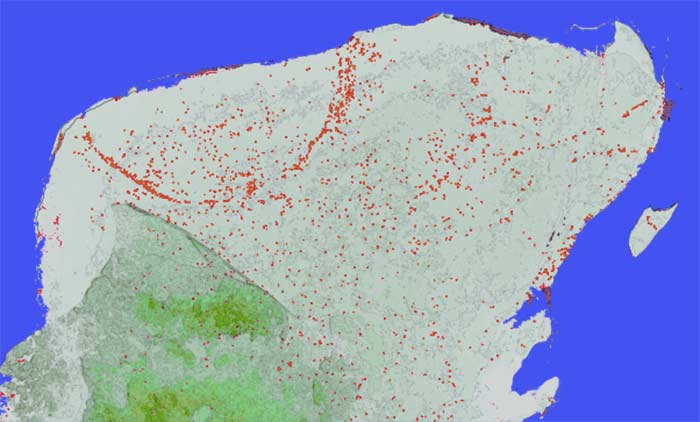
Each red dot is a cenote. The semi-circle is the Ring of Cenotes with Homun in the center. You can also see the large number of cenotes down the Caribbean coast. There is a line from Puerto Morelos leading inland – the Ruta de los Cenotes (The Cenotes Route).
SECTION 1 – RIVIERA MAYA CENOTES
The following are the best cenotes if you are on holiday in the Riviera Maya.
We have visited these many times and, normally, found them uncrowded and great fun.
This list does not include some well-known cenotes that are included in hotel day trips. We do not like nor do we visit over-crowded cenotes. It’s just a personal preference.
Cenote Yax Kin – Great Cenote near Tulum for avoiding crowds
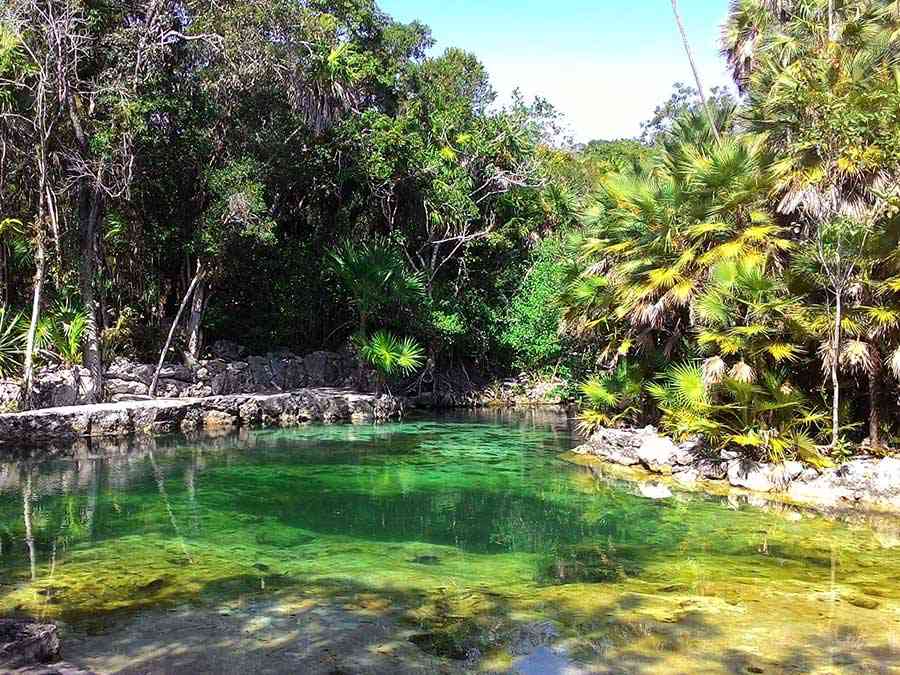
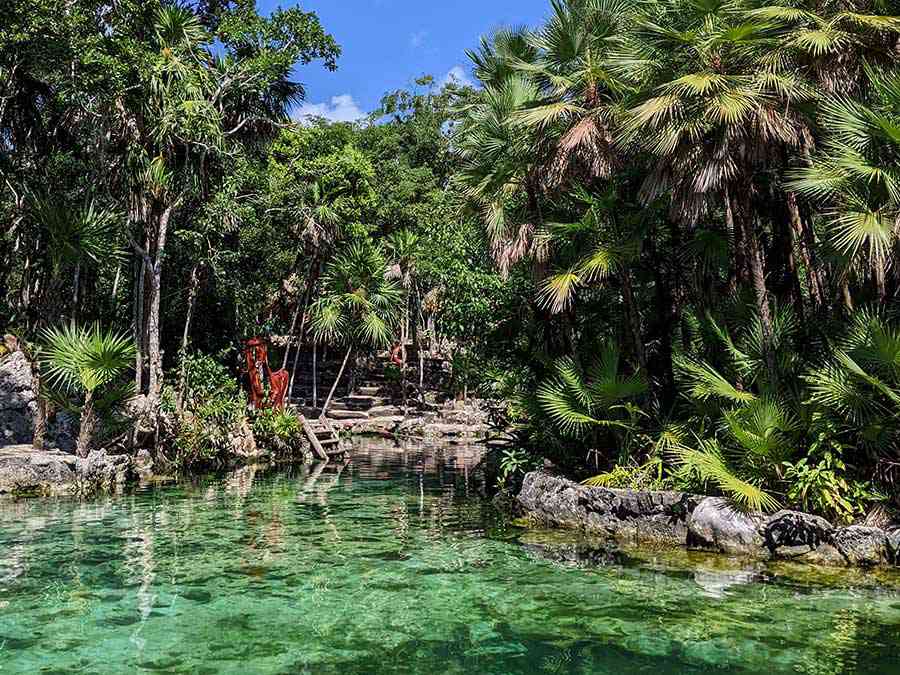
In our opinion, Cenote Yax Kin is one of the best cenotes in Tulum. Many of our friends rate it the one best cenotes in Riviera Maya. You can decide when you visit.
It’s situated on a road leading out of Tulum and, being a little more out of town, is normally less crowded. By avoiding weekends and public holidays we’ve had the cenote to ourselves, which is superb! Obviously, there’s an element of luck with crowds but, if you do miss them, this is a wonderful, relaxing cenote.
Cenote Yax Kin is an above-ground cenote, that roughly runs in a circle. The crystal-clear waters are set in beautifully landscaped grounds. There are plenty of butterflies and birds – and iguanas if you look for them sunning themselves.
The water on the side of Cenote Yax Kin near the restaurant is shallower, making it great for kids, whereas the water on the further side is deeper. There are plenty of fish anywhere in this cenote if you’re snorkeling. However, in the deeper area, where the roots dangle down from the high banks, you’ll see dozens. Along with Mexican Mollies, there are Mojarras which can grow to 6 inches (7cm) in length. These tend to lurk lower down and in the rocky overhangs. It’s like snorkeling in an aquarium.
The cenote is nicely set up, with a good car park, nice toilets, and life jackets and snorkels for hire if wanted. The small restaurant serves nice food and refreshing juices.
Admission in 2023 is 120 pesos per person.
Cenote Azul – Cenote near Tulum for feet nibblers
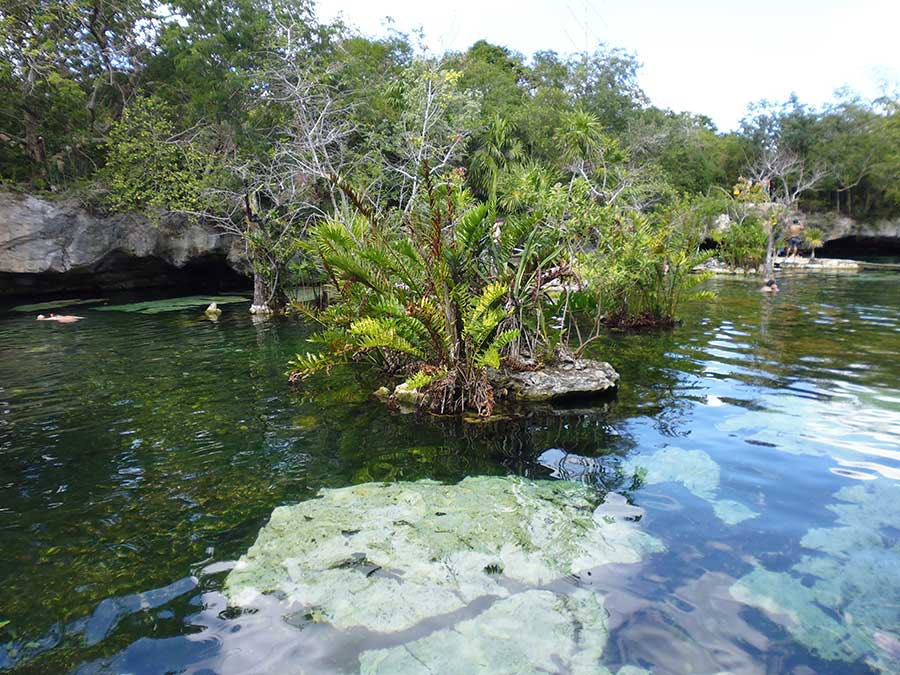
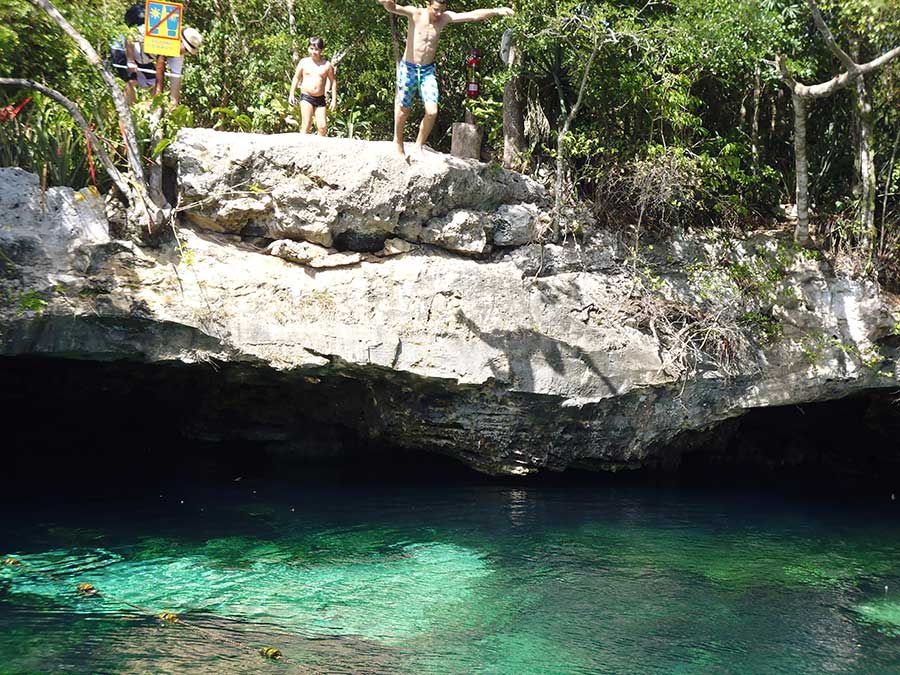
Cenote Azul, so called due to its deep blue color, is an open-air cenote within easy reach of the main resorts of the Riviera Maya, such as Cancun, Playa del Carmen, and Tulum. For this reason, it can get crowded. Even if you can’t avoid weekends and public holidays, it is large enough to allow for some great fun.
The pool has two distinct areas, a shallow area with slabs of large rocks and a bigger one deep enough for those brave souls who want to jump 12 feet (3.5 meters) from the cliff (really just a high bank)! For the fainter-hearted (like me), it’s good fun to watch.
Snorkeling is good, with many Mexican Mollies, small catfish, various cichlid species, and the ever-present feed nibbler fish. You can buy fish food but, in our experience, just putting your feet in the water will soon bring the nibblers. And save you a fortune that you would have spent in a 5th Avenue spa!
Finding a quiet spot to sit with your feet in the water normally means a walk along the track that meanders among the trees on the shoreline. There are little ‘coves’ that provide an element of seclusion if you walk far enough. Or avoid the trek and stay with the crowds nearer the walkway.
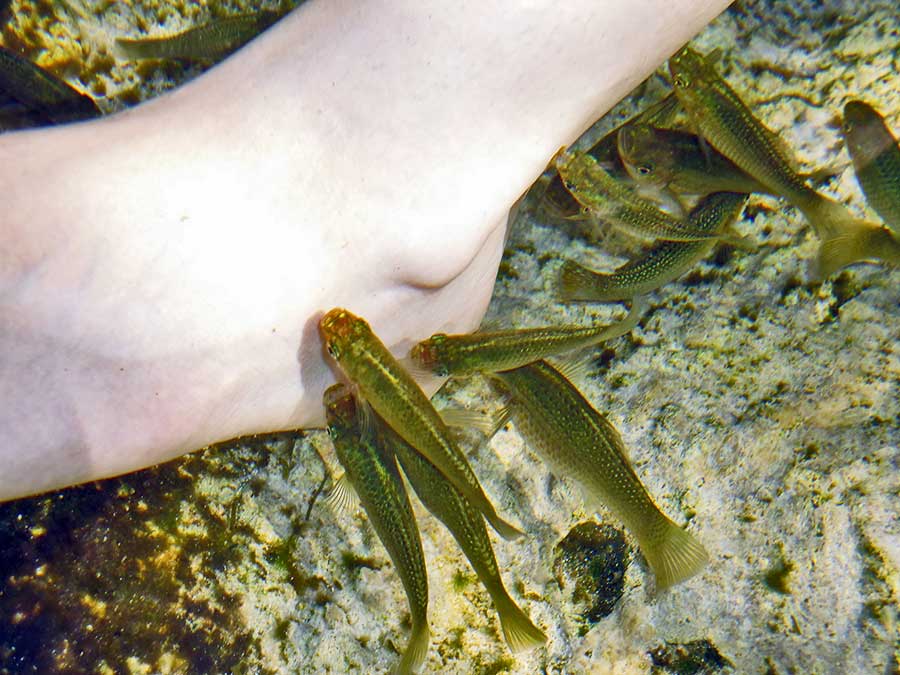
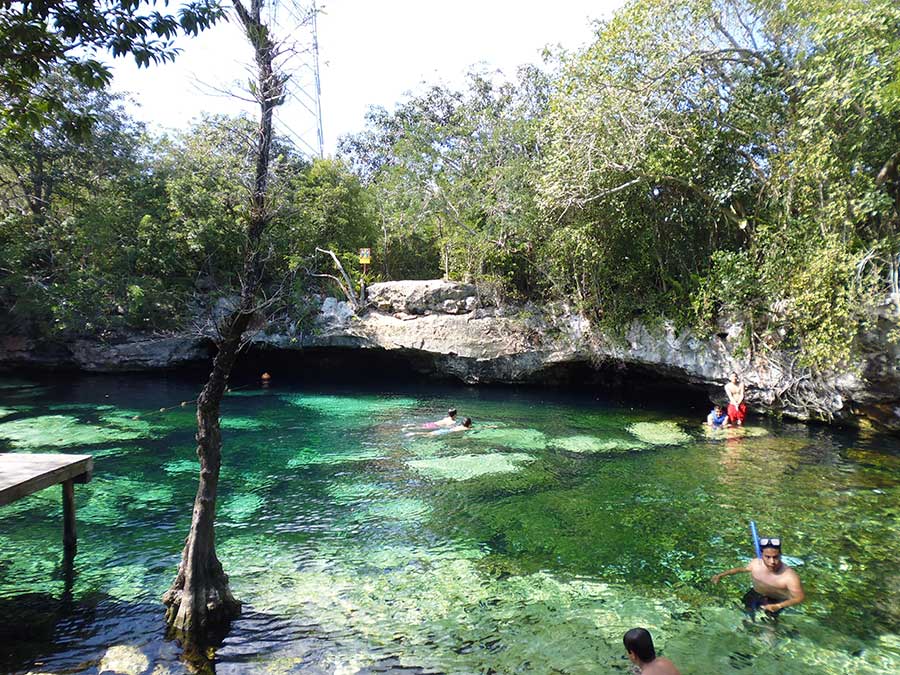
What are the facilities at Cenote Azul?
The shallower part of the pool is only about five and a half feet (1.7 meters) deep at its deepest, so you can find areas for the kids to swim safely. The slabs of stones which rise to just below the water’s surface are limestone and in some places are safe to walk on. But in many areas, they are covered with slippery algae often just deep enough that you can’t see it, so be careful.
You can bring a picnic, although is a small stall where you can buy snacks and drinks. There are changing rooms and toilets (both with a small charge).
You can rent life jackets, snorkel gear, etc. Flippers are not allowed in Cenote Azul (and would be unsafe with the algae and rocks anyway).
Cenote Azul is about 25 minutes from Playa del Carmen and roughly 40 minutes from Tulum.
Admission is 200 pesos.
Cenote Carwash – Best Cenote for seeing Divers in the water
Cenote Carwash, officially known as Cenote Aktun Ha, is an open-air cenote. It’s large at about 160 feet wide (50 meters). Surrounded by lush bushes and trees, it has a jungle feel.
In Mayan ‘Aktun Ha’ means ‘water cave’. The origin of the name Carwash is vague with two possible stories. One says a carwash used to be nearby (but has long gone), the other is that the water from the cenote was used to wash cars here. Take your pick!
A large patch of water lily leaves near the deck caught my interest during our visit. I couldn’t snorkel close as they were behind rope barriers to keep the swimmers away from scuba divers. Despite the rope, it was fascinating to see the bubbles rise through the deep dark waters, to be followed by divers!
The snorkeling is great, with a variety of fish. Allegedly, small crocodiles are lurking in the depths. But sightings of any Cenote Carwash crocodile are uncommon and their size makes them harmless – but what a story if you got to see one!
Access to the water is via steps from a wooden deck. There’s a jumping platform, plus a rope swing to add to the fun!
Cenote Carwash is popular with scuba divers as it’s up to 50 feet deep. It’s also known for its cavern diving (for which you need to be a certified cave diver).
Cenote Carwash offers showers, toilets, changing rooms. Lockers are available.
On the day we were there, by 10 am the place had become crowded so we left early. We may have been unlucky.
Cenote Carwash is close to the road, making it easily accessible. With a safe shallow end, this cenote is popular with families.
The entrance fee to the Car Wash cenote is 300 pesos.
Casa Cenote – best Cenote for snorkeling and a crocodile
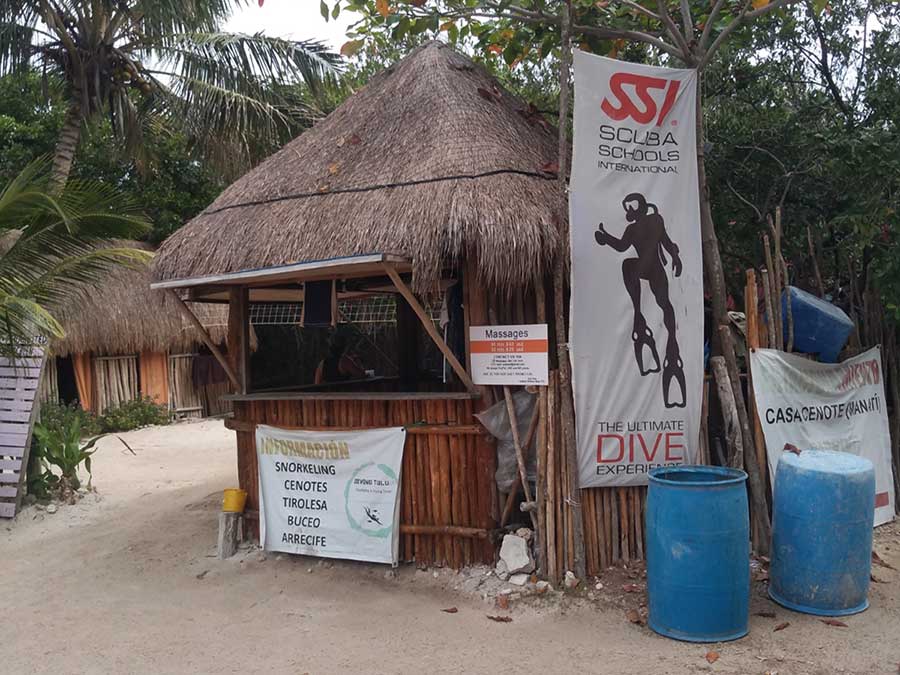
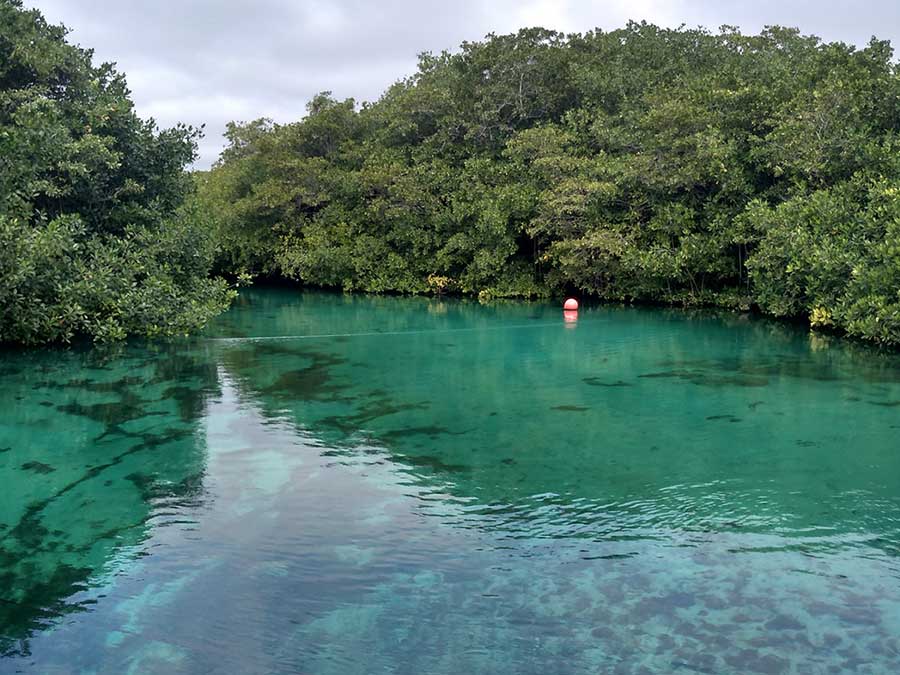
The entrance and huts for Casa Cenote, also known as Cenote Manati or Cenote Manatee, are very close to the road and the cenote itself can be viewed from the road. A natural tunnel runs 160 feet (50 meters) from the ocean, deep under the road, and into the cenote. This creates brackish water where you enter the water by the road.
I would rate this one of the best cenotes for snorkeling. Unlike other cenotes that just have freshwater fish like cichlids and Mollies, Casa Cenote boasts some seawater fish as soon as you jump in (or climb down the short ladder).
The cenote meanders back from the road over 800 feet (250 meters) between tall banks of mangrove trees. This makes for spectacular snorkeling. The roots of the mangrove act as a nursery for small fish. Clouds of fry dart in and out of the tangle of fine roots hanging down in the water. Getting from one end of the cenote to the other involves a lot of swimming. As it is connected to the sea via a tunnel, you may be swimming against a slight current at some points. It’s not strong but worth being aware of.
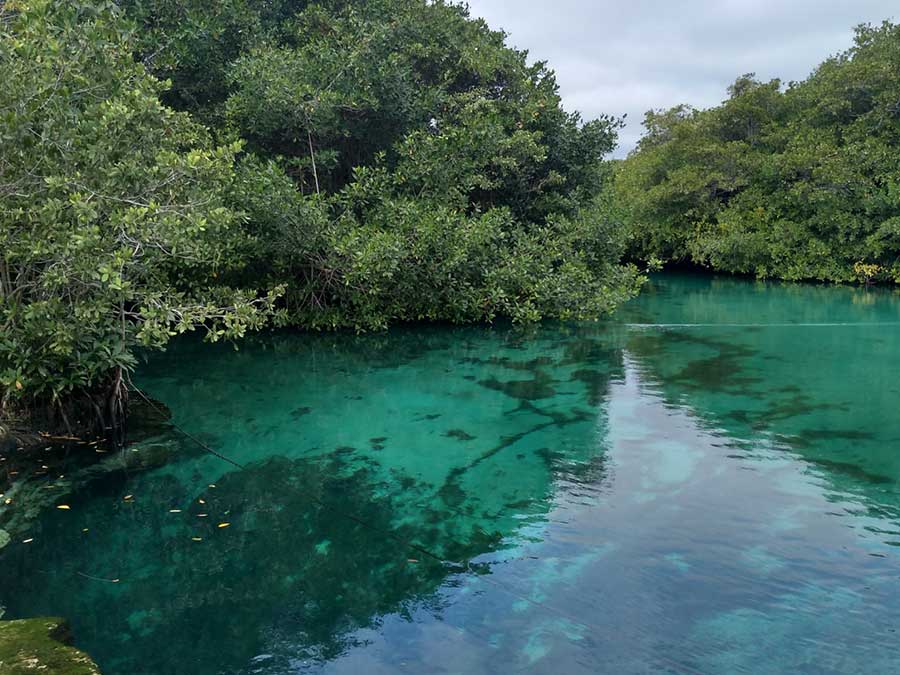
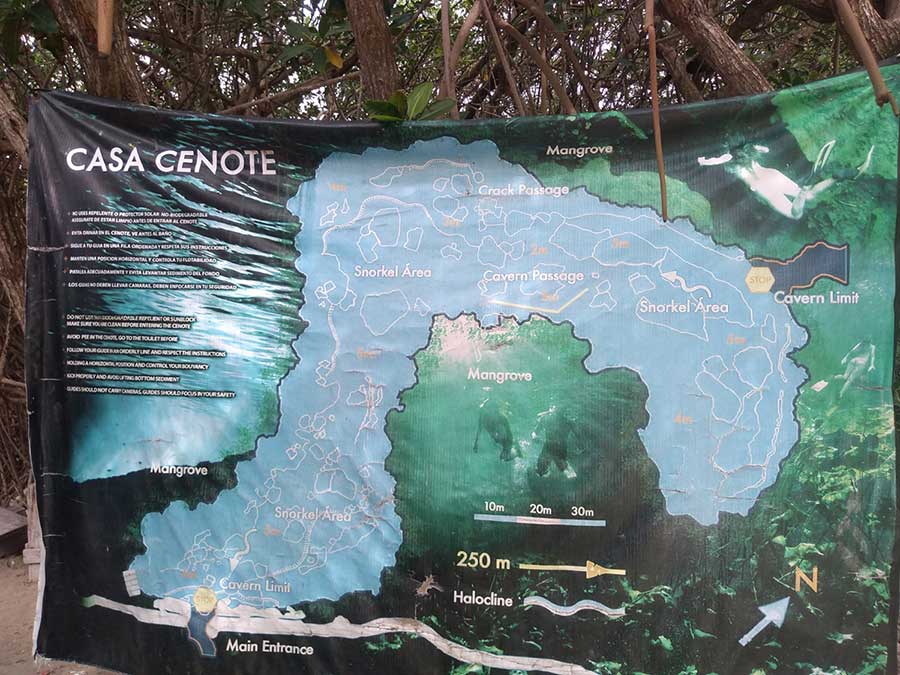
Lots of Fish and a Crocodile called Pancho!
If the chance of seeing ocean fish at one end of the cenote and masses of small and large freshwater fish along its length isn’t enough – look for Pancho (also known as Panchito).
Pancho is the resident Casa Cenote crocodile. He is (supposedly) harmless and used to the many snorkelers that go up and down the cenote each day. That said, I’ve looked for him several times and never seen any sign of him. Which may be a good thing?
Although snorkeling is great fun, scuba diving at Casa Cenote is very popular. The mix of sea and fresh water, with the range of fish, plus the tunnel from the sea might make this the best of the cenotes to scuba dive.
Casa Cenote is also known as Casa Manati, after a family of manatees that used to frequent the cenote. Sadly, that was many years ago.
This cenote is one of the ocean exit points of the Sac Actun cave system, the longest one in the world at 368 km ends here where it mixes with the warm salt Caribbean waters.
Casa Cenote is 20 minutes from Tulum but you need to come off the main road. Public transport isn’t much use getting to this cenote, which is one reason it doesn’t get overly crowded.
If you are staying in Tulum, it’s an easy 20-minute drive from Tulum beach road.
The entrance fee is 150 pesos.
SECTION 2 – HOMUN AND OTHER CENOTES
These are cenotes that are inland. They make great day trips from Valladolid and Merida.
By being away from the Riviera Maya, they are rarely as crowded. Some are a little more basic than the more-frequnted cenotes by the coast. But for us, that adds to the experience.
These cenotes also have a slightly ‘feel’ to them. They tend to be more semi-open or underground and the limestone formations are a little different.
These are all great day trips if you have the time!
Cenote Kankirixche – The best Cenote close to Homun
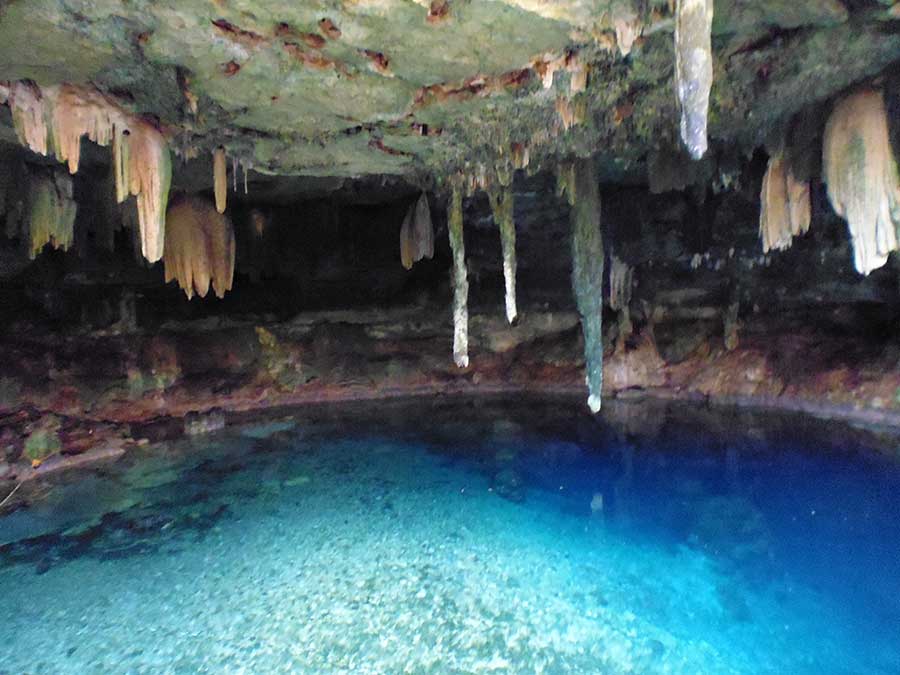
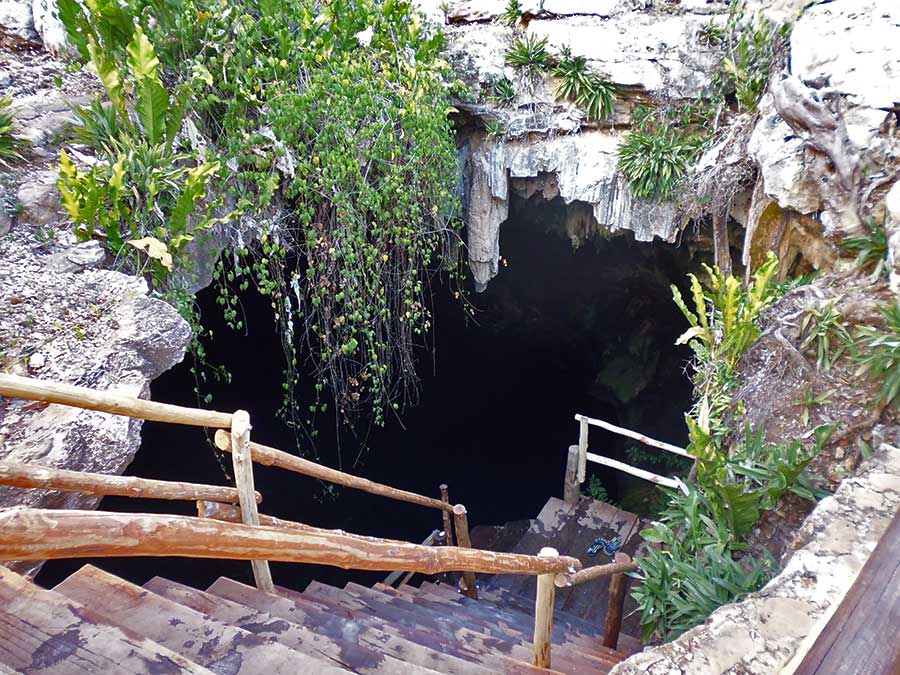
Situated about an hour from Merida and the same from Homun, the Cenote Kankirixche is a lovely semi-underground cenote. It’s close to the small town of Abala and can be reached by driving along a dirt road just over a mile and a half long (2km).
In Mayan, Kankirixche means “tree of yellow fruit”.
The cenote is accessed via a series of wooden steps that lead down to the crystal-clear water. At the bottom of the steps, there is a small platform. This makes it easy to get in and out of the water.
The feeling of being underground, with the opening to the sky above you is awesome, especially if this is your first cenote. The hanging vines add to the atmosphere. Stalagmites rise from the bottom of the water, which in places is so deep the water looks black. Toward the back of the cenote, huge stalactites hand down close enough to touch. (Although you are discouraged from doing so.)
If you snorkel, you’ll see plenty of fish. The bigger ones swim deeper and are harder to photograph but catfish and cichlids are waiting to be snapped in shallower water.
There are toilets and showers, with a basic restaurant. Life jackets are provided. You can rent snorkel equipment.
The entrance fee, like many cenotes seems to go up every time we visit. In 2023, it was MXN70 per person.
While this may not be one of the best cenotes in the Yucatan, we’ve been back several times. It’s fun!
Cenote X’Batun – a lovely cenote near Merida
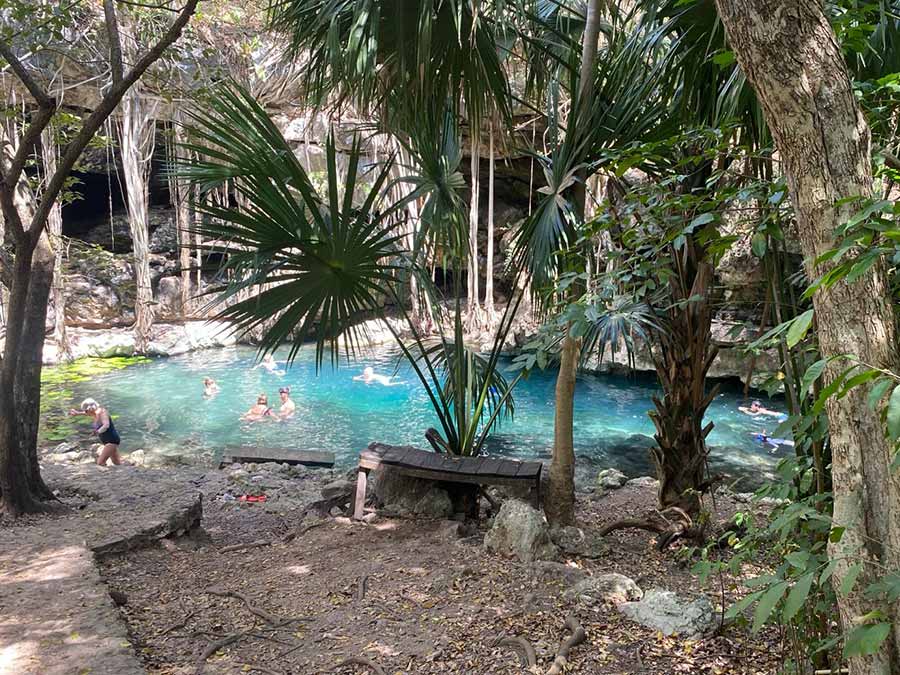
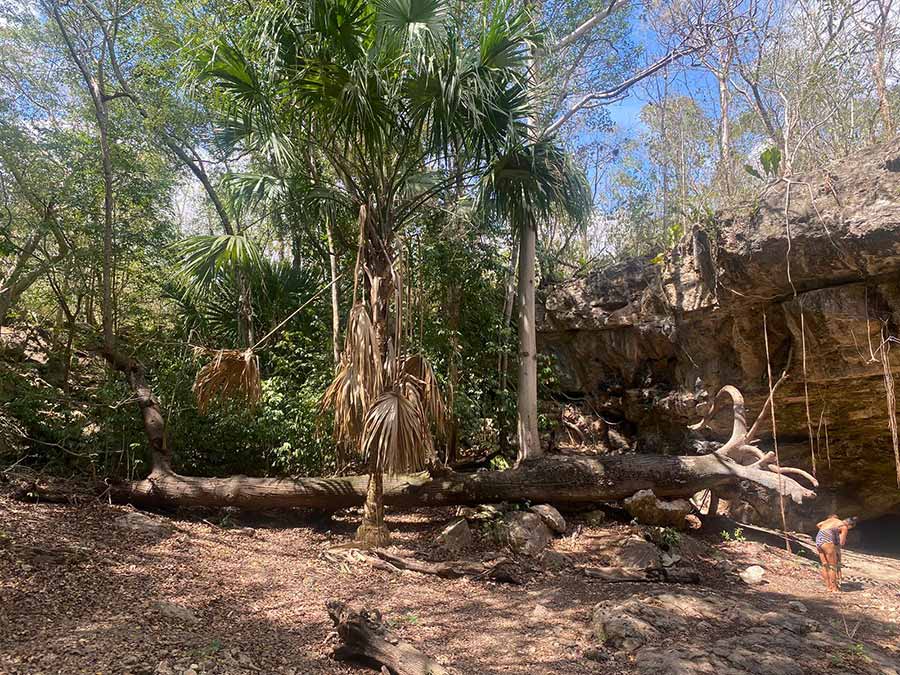
Cenote X’Batun or Cenote Xbatun (or even X Batun – there are many variations), is a lovely cenote.
It’s only about an hour’s drive from Merida and perhaps an hour and 45 minutes from Homun.
It’s an ideal stopover if you’re doing other day trips from Merida, such as any of the Haciendas, Uxmal, or other cenotes.
Our first attempt to visit it was after visiting Cenote Kankirixche. The road to Cenote X’Batun is a bit complex. First, you have to drive to the small village of San Antonio Mulix.
In the village, by the park, you’ll find a hut that sells tickets to the cenote (as well as to another cenote, which is not such a nice one – Cenote Dzonbacal. Then it’s about a mile and a half (2.2km) along a dirt road. There are signposts.
Initially, the entry cost was higher than we expected – MXN150 per person. It’s MXN 75 for residents (which was great!). By the time we sorted that out a large group of cyclists arrived, bought tickets, and shot off down the dirt road to the cenote. We abandoned the trip on that day as it was obviously going to be crowded.
And that is one of the main problems with Cenote X’Batun or Cenote Xbatun. It can get crowded. It’s never as crowded as any along the Riviera Maya but, for us, the beauty of these smaller cenotes is the atmosphere.
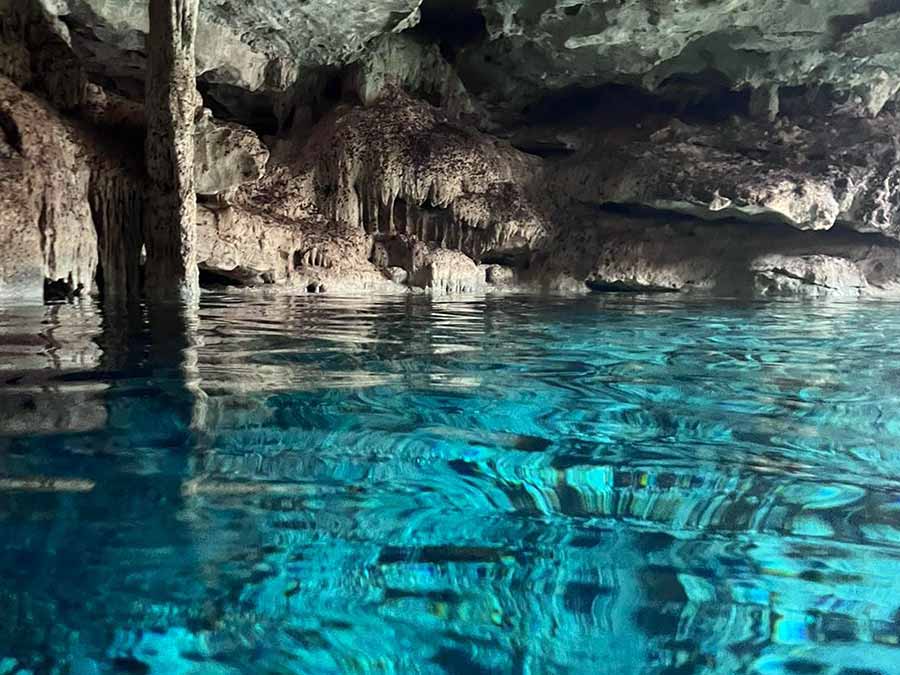
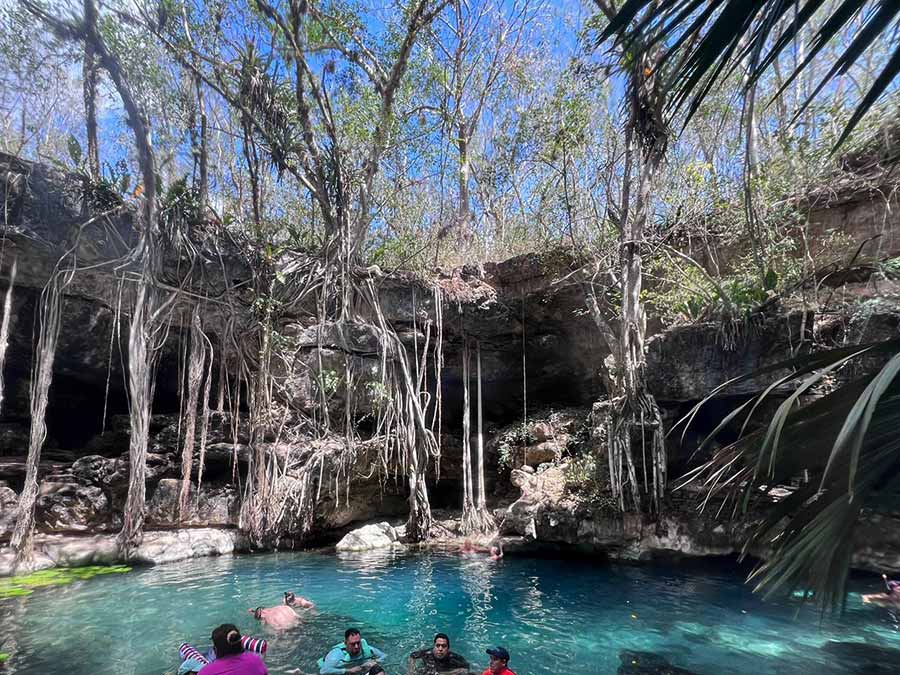
Avoid the crowds and enjoy the calm of Cenote X’Batun
Going later, when there were no crowds reveals a lovely cenote with some interesting features. If you can, aim for earlier in the morning. The afternoons are more likely to be busy.
Cenote X’batun is an open cenote. But it has a feature that is uncommon in nearby cenotes – you can dive under the rocky ledge and there is a deeper and long ‘cave’. Which adds to the fun. There are plenty of cenote fish to be seen.
The cenote is in a dip, with high rock walls. There are some very photogenic trees along the ridge, with roots hanging down to the water.
The surrounding vegetation is also fascinating. There are some lovely birds to watch, butterflies flit about, and, of course, iguanas. The whole area has a natural, calm vibe.
Cenote Yaxbakaltun – Best Cenote in Homun with a swing rope
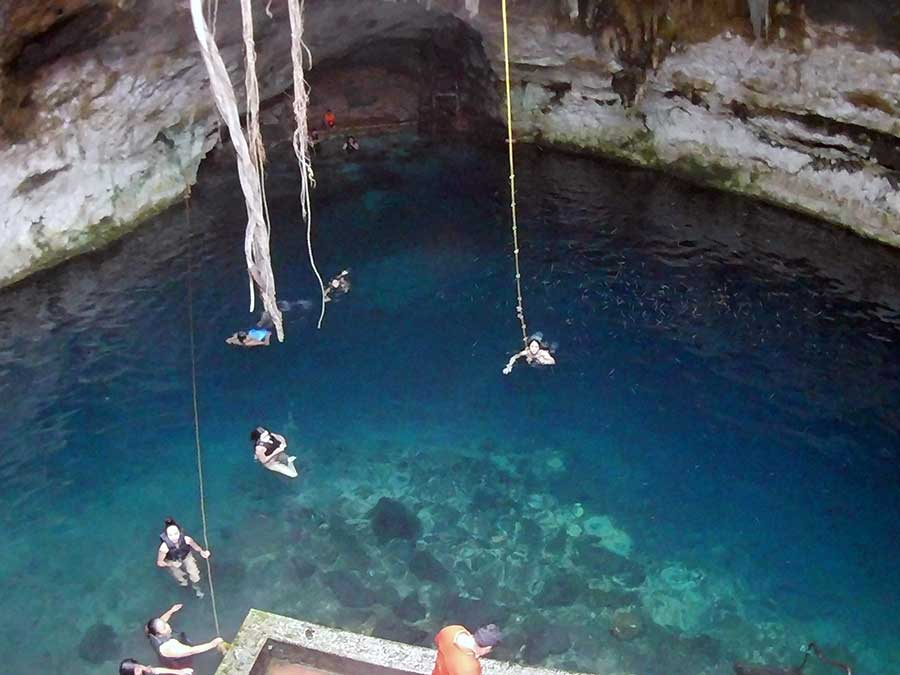
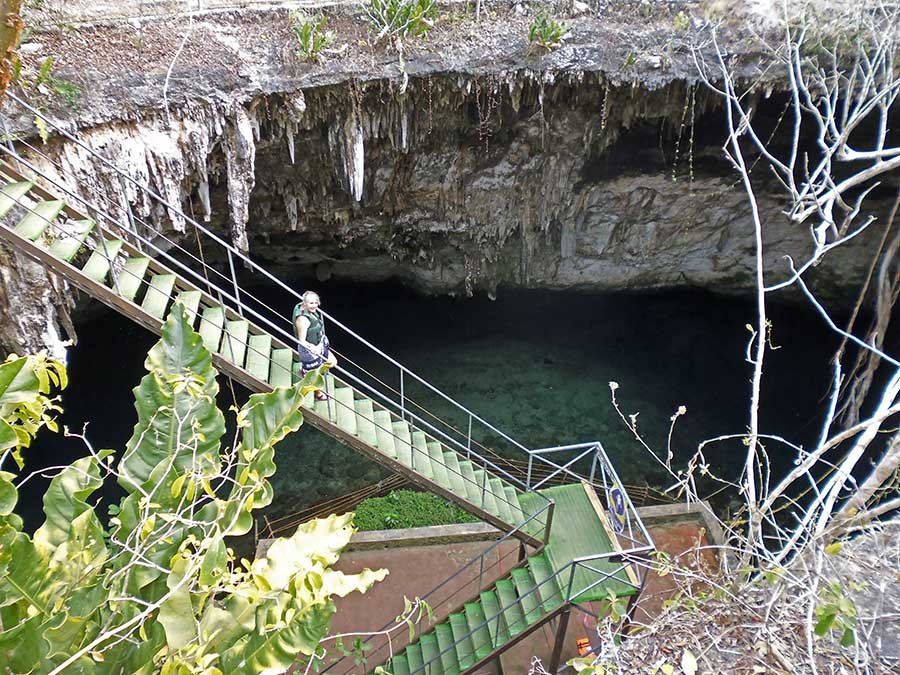
Cenote Yaxbakaltun is another example of a semi-open cenote, situated in the Homun Cenote area. It is larger than the Cenote Kankirixche and feels less crowded if there are larger groups present.
Like so many cenotes, getting to Cenote Yaxbakaltun requires driving off the tarmac road and driving along a dirt road. This is about a mile (1.5km) long and you need to look out for a sign a little over halfway along the road.
Access to the cenote is down a long set of stairs, in two sections. At the bottom of the stairs is a large platform.
There are stalactites and stalagmites, but these are around the edges and not as prominent as Cenote Kankirixche. The water near the platform is relatively shallow but gets deeper the further back into the cenote you swim. At its deepest, the water is supposedly 90 feet deep (27 meters).
One of the best cenotes in the Yucatan with a swing!
A plus when visiting Cenote Yaxbakaltun is the swing rope. When we ask our guests, they are unanimous that this is one of the best cenotes in the Yucatan where they’ve swung on a rope and plunged into the black waters!
Even if you don’t want to use the rope to swing out over the dark waters and let go, it’s great fun to watch others. Some visitors have the knack of swinging way out, dropping elegantly into the water with barely a splash. Others are less skilled, landing with a huge splash and a tangle of arms and legs!
The basic facilities of a shower, car park, life jackets, etc., are available. There was a small collection of animals at one point but on our last visit many of the cages were empty. (Given the size of the cages, this is a good thing!)
The entry fee is about the same as Cenote Yaxbakaltun.
Mayan Culture and Legends about Cenote Yaxbakaltun
The cenote has had spiritual associations with Mayan culture for centuries. Several legends and stories have grown up around the cenote, such as the water’s healing properties. (Some may be more for the benefit of tourists than the local residents.)
In Mayan, Yaxbakaltun means “Green cob on stone.” This obscure meaning is linked to a legend about a time when the corn crop was not doing well. One farmer disappeared and in the hunt for the missing farmer, an opening suddenly appeared which led to the cenote.
On July 15th each year many visit the cenote in the hope of seeing the reflection of a green cob in the waters. Such a sighting allegedly brings great good fortune for the coming year.
Toh birds (Eumomota superciliosa), which also have Mayan legends associated with them, are frequent visitors to the cenote and surrounding area.
Grotto and Cenote La Canderia – Best Cenote for quick, safe ‘adventure’
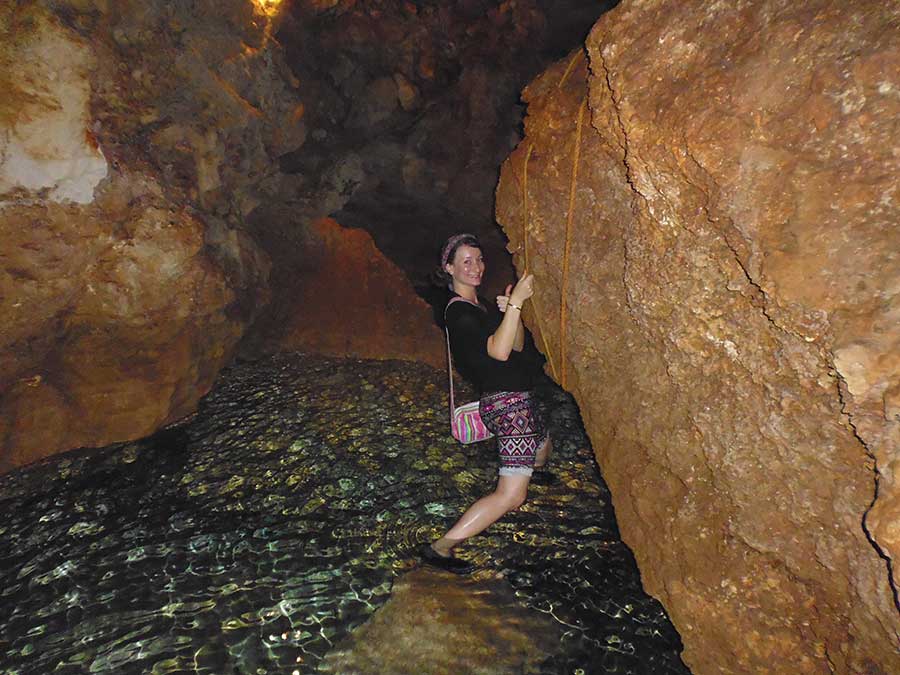
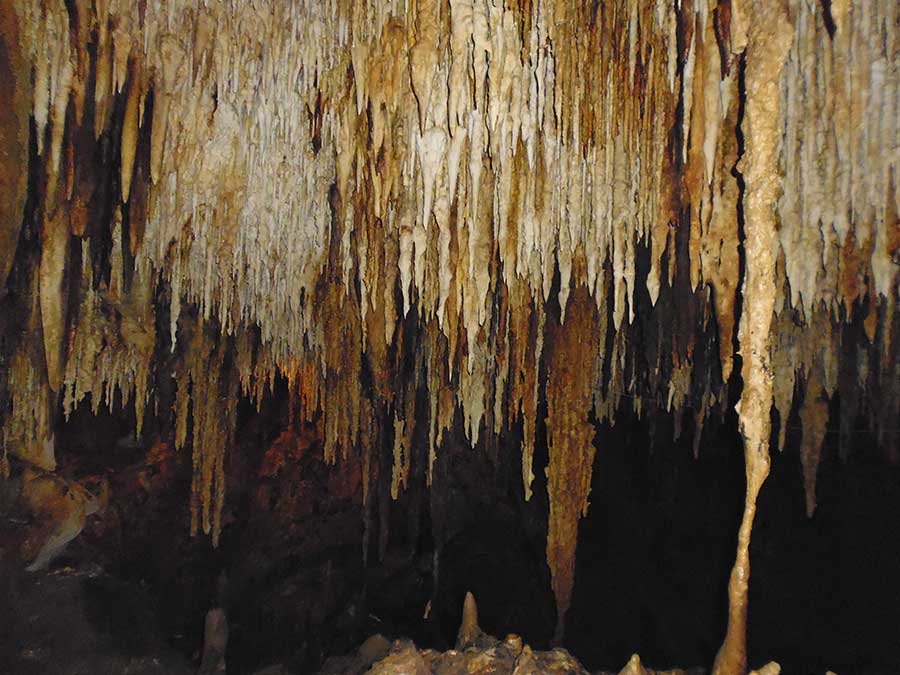
One of the Best Cenotes in the Yucatan for adventure!
Unlike the other cenotes in this blog, you can’t swim in the Grotto and Cenote La Candelaria. This is effectively a ‘proper’ cave with a small cenote at the bottom. But it’s good fun.
To enter the cave, you must negotiate some rock steps down a hole next to the roots of a large tree. This adds to the feeling of adventure! Once you get down the steps, you see the cave itself with the stalactites and stalagmites. There are lights scattered through the cave to provide some illumination but they’re not bright.
Grotto La Candelaria is not a big cave but that adds to its charm. As you walk further into the cave, it narrows until you are forced to crouch to avoid hitting your head on the low ceiling.
Once you emerge into the cavern, you see more stalactites and stairs leading down to the underground cenote.
At this point, you need to make a decision – go back the way you came or scramble over rocks and follow the cenote in the partial darkness. Both routes take you back to the entrance.
Lesley opted to go back. Tabitha and I went the ‘difficult’ route. This is not a big cenote! It’s narrow and not that long. After heavy rain, I assume it fills more but it’s still exciting to clamber along its edge in the partial darkness, trying to avoid slipping into the water.
It doesn’t take long to come to a gap in the rocks with a path going steeply back up to the entrance.
The whole walk doesn’t take long. But it’s worth a detour for the fun and experience.
The entrance fee is 50 pesos. Camping is possible in the grounds.
Santa Barbara Cenotes – Best Cenote for a family day out
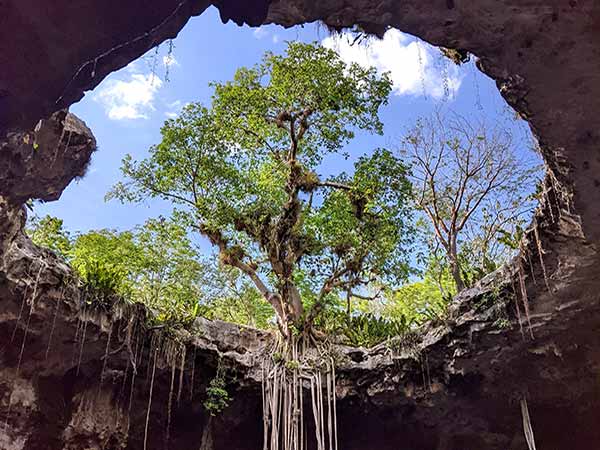
Santa Barbara Cenotes is very popular and high on the tourist list, with buses arriving from mid-morning. Many view it as one of the best cenotes in Homun, for many it’s high up in the list of the best cenotes in the Yucatan.
It can get crowded later in the day, so an early start is recommended.
Santa Barbara Cenotes is not one cenote but three cenotes close to each other offered as part of a package. That alone makes it on of the best cenotes in the Yucatan for valte!
You can choose a ticket just for the cenotes or include a meal. The food is not bad, so you may feel it’s worth getting the full ticket.
To travel between the three cenotes, you can use the bikes or the horse-drawn carriages, both are included in the price of the ticket.
The Santa Barbara estate was originally a hacienda involved in growing sisal. Although the horses pull the carriages along the railway tracks used to move the sisal around the estate, I felt sorry for them dragging carriages about in the heat.
I opted for the bikes – and soon felt sorry for myself in the heat! But the cycle ride was interesting and short between each cenote.
The best cenotes in the Yucatan for Value for Money?
The three cenotes are:
Cenote Cascabel
This closed-type cenote is perfect for lovers of exploring underwater caves and rock formations. It’s accessed by going donw a steep wooden staircase that takes you through a smallish hole (not so small you should worry!)
With a maximum depth of 10 meters, you will be able to experience up close the beauty of this cenote illuminated with artificial light. The only downside for me was the water didn’t seem as clear as other cenotes I’ve visited.
Cenote Chacsikín
This semi-open type cenote offers a unique experience with sunlight that illuminates the crystal-clear blue water.
Dive into the depths and explore this cenote with a maximum depth of 16 meters.
Come discover the magic of this natural wonder and create unforgettable memories with family and friends. You can see the large roots that sprout from the trees above. The stalactites are really good and add a nice visual attraction.
This cenote is also accessed via some wooden stairs. But the opening is much larger than Cenote Cascabel.
Cenote Xooch’
For me, this was by far and away the best of the three cenotes. The water of Cenote Xooch’ seemed cleaner and I enjoyed the natural beauty of this open-air cenote.
Access is via a tunnel.
At about 40 meters deep, this incredible cenote is perfect for swimming.
It’s impossible not to admire the rock formations, and relax in its impressive turquoise waters and the exuberant jungle that surrounds it.
Another of the attractive elements of this Cenote is the large “Alamo ” tree that is located in the entire diameter of the opening of the pond.
One hour from the city of Merida. The Santa Barabara Cenotes park is located at the western entrance of Homún, about 50 kilometers east of the town of Mérida.
Ik Kil – The best Cenote near Chichen Itza and Most Famous
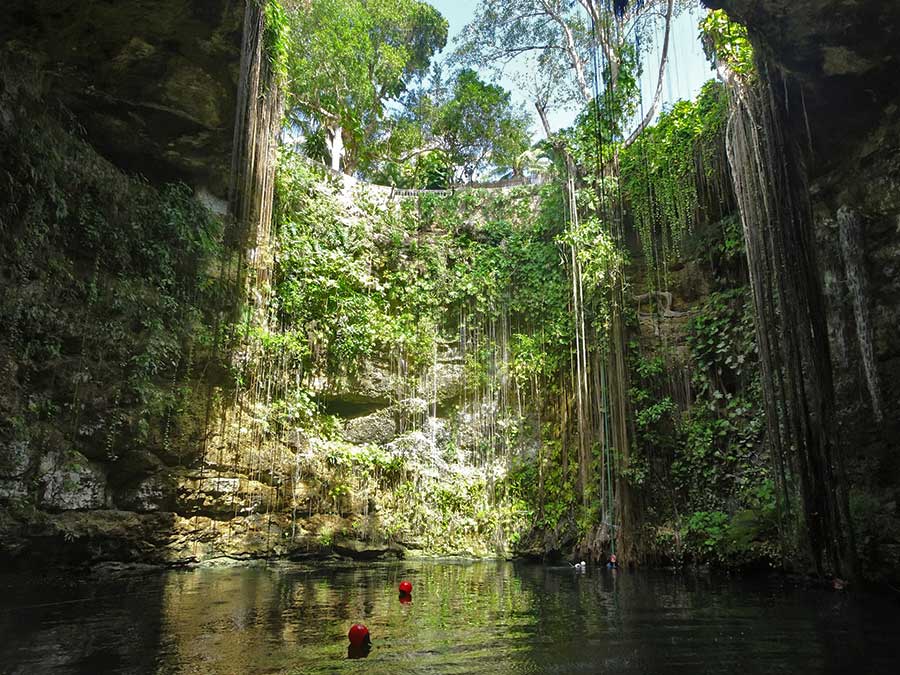
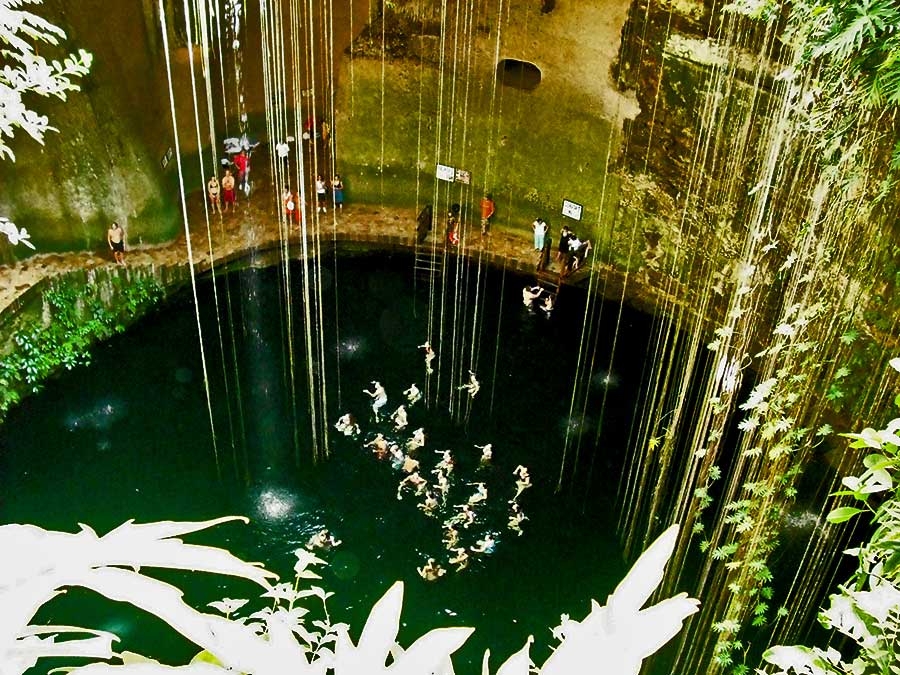
The first cenote we visited in Mexico was Ik Kil was the first cenote and it remains, in our minds, one of the most iconic. We saw it as part of a tour to Chichen Itza and were taken aback by its beauty. The way the vines and roots hang down, and the fact the water is 85 feet (26 meters) below ground level with the way the sky is an almost perfect circle way above you, all make it both beautiful and spectacular.
(The various depths and heights vary due to the rains as they are affected by the aquifer).
To get to the water, you clamber down a stone staircase. The water is 130 feet (40 meters) deep and nearly 200 feet (60 meters) across. Initially, it’s a bit unnerving when you jump into the water – it’s very clear but dark, so there’s a feeling of the unknown lurking deep beneath your feet! The water is also colder around your legs if you sink a bit, which adds to the sensation.
Cenote Ik-Kil is linked with the Mayan religion and it is still considered sacred. In Mayan ‘Ik Kil’ means ‘The Place of The Winds’. Archaeologists have discovered artefacts that indicate human sacrifices were offered here. It is important to respect the heritage here when visiting.
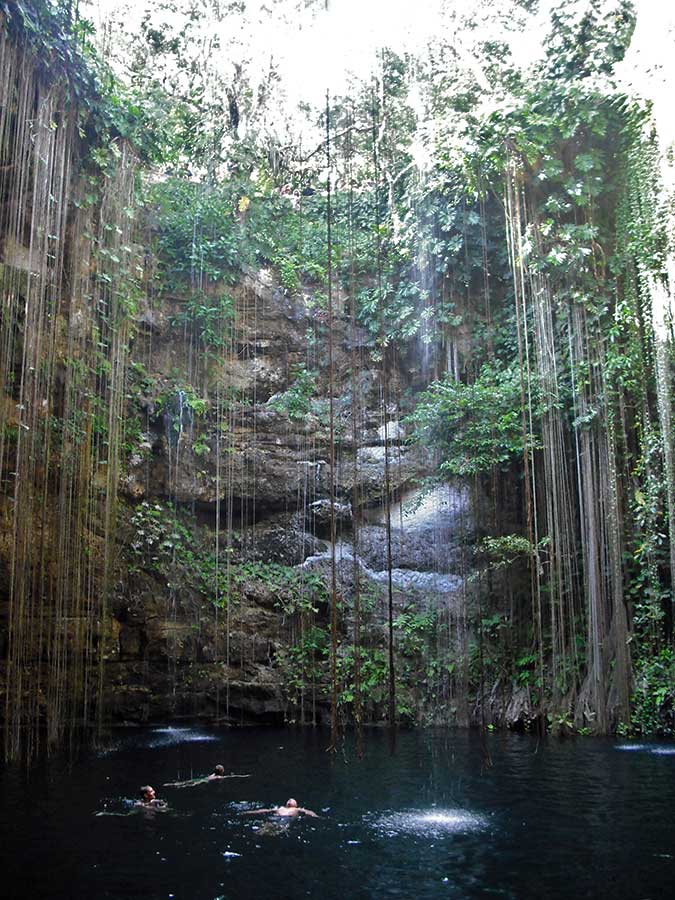
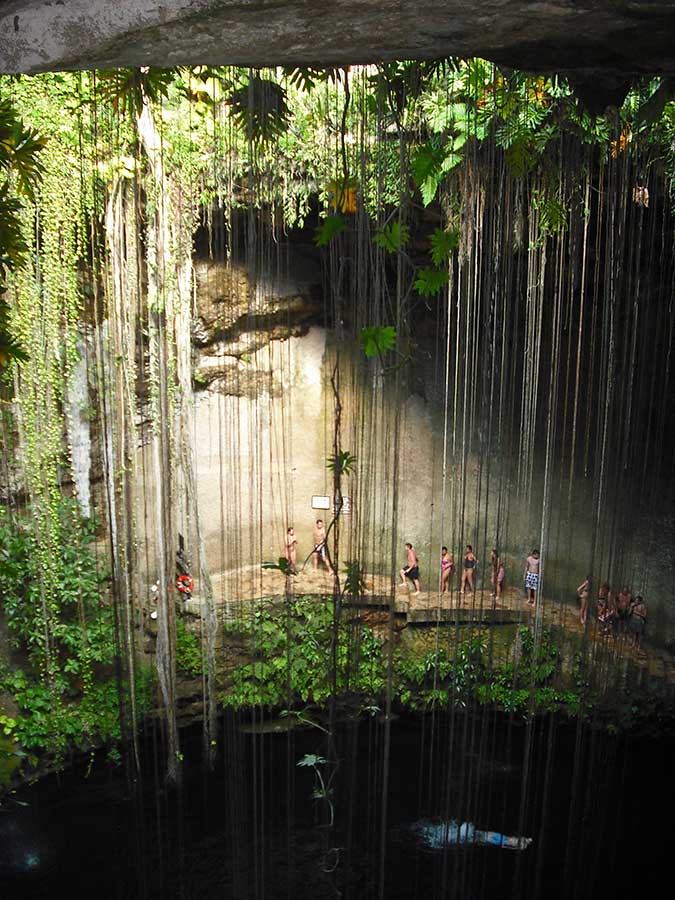
Should I avoid Ik Kil because of the crowds?
By being the closest of cenotes in Chichen Itza and often included in the same tour, it can get crowded. However, it’s a big cenote, so it can accommodate a lot of people. It’s also well-equipped for tourists, with a restaurant, lockers, showers, changing rooms, etc.
If you’re not coming as part of a tour, you may want to visit the cenote before Chichen Itza. The cenote is near the town of Piste on the road from Valladolid just before you reach Chichen Itza.
Cenote Ik Kil is equipped for the large number of tourists it receives. Lockers, showers, changing rooms, etc., are all provided. There is a restaurant here to get food and drink.
Although part of a tour, we were fortunate to avoid the worst of the crowds and it was a magical experience.
Other places to see Great Cenotes in the Yucatan
Above, I’ve listed what are, in my opinion, the best cenotes in the Yucatan and near Tulum, which makes them accessible form anywhere in the Riviera Maya.
There are many cenotes in both the Yucatan state and Riviera Maya, so you will have no difficulty finding many to visit.
Whether you are staying in Merida, Valladolid, or Progreso in the Yucatan or on the Riviera Maya at Tulum, Playa del Carmen, or Cancun, you’re spoiled for choice.
Most hotels at any of the tourist centers offer cenotes tours and packages, enabling you to visit several in one day.
But if you’re a Cenote fan, you may want to do more visit more than one. It’s easy to fit in two, three, or even four cenotes in a single day. The trick is to find places where there are clusters of cenotes close to each other.
With Xlacah cenote closed indefinitely, it’s worth noting that there are no cenotes in Merida currently open to the public. Unless one counts the small Cenote Ka Kutzal in the car park of Merida Costco!
Here are some options:
Homun is a town about an hour from Merida. It’s fair to say that in the Homun area, you’ll find the best cenotes in the Yucatan, simply because it’s in the Ring of Cenotes. There are 20 cenotes within easy reach of the town.
The Ruta de Cenotes running from Puerto Morales inland has 12 cenotes. Some tour operators will allow you to visit four in one trip.
Valladolid is outside the Ring of Cenotes but, aside from being a great cultural city, has over 13 cenotes, which include the world-famous Ik Kil near Chichen Itza. Given the number of photos online and the huge crowds, maybe this should be top of the list of the best cenotes of the Yucatan!
12 Safety Tips to Protect You and the Cenote
Cenotes can be great fun but there are a few things you need to know to enjoy your time without any mishaps. Also, the cenotes themselves have rules that you may not be aware of, so forewarned is forearmed!
1. Use bio-friendly sunscreen
Without tides or rivers to change it, cenote water is affected by what goes into it. Most cenotes have rules that only permit the use of reef-friendly bio-sunscreen. If you’re visiting an open cenote without sunscreen, the Yucatan sun can be fierce. Invest in a good reef-friendly bio-sunscreen before you so you don’t get caught out. They can be expensive in the tourist areas like Tulum, Playa del Carmen, and Cancun.
2. Shower before you enter the water.
Most cenotes ask you to shower before you enter the water. Have a towel handy.
3. Keep valuables safe.
At some open cenotes and even semi-open cenotes, you may quickly be out of sight of your belongings. Don’t leave valuables on show. Preferably, leave them at the hotel (or locked in the car, if you have driven).
4. Wear reef shoes
Many open cenotes have rocks scattered around the bottom. Some are small, some are big. The combination of freshwater and sun is ideal for algae. You will find some areas incredibly slippery! Reef shoes with a good grip can save you a lot of grief and scrapes!
I’ve also found that some of the steps or stairs down to the water in semi-open cenotes can be slippery.
5. Wear a hat
This is obviously a personal choice but I always wear a baseball cap when I’m in an open- cenote (unless snorkeling). The sun can be unrelenting and the reflection of the water strong.
6. Snorkeling
To me, snorkeling in cenotes is a must! There are always fish and often weird rock formations or stalactites. You may even be lucky and see a turtle or one of the elusive crocodiles. You can rent masks and snorkels at most cenotes. Old, used snorkels have never appealed to me. They take up little room in your suitcase, so why not bring your own?
Not all cenotes allow the use of flippers, so they may be something you leave at home.
7. Bring cash
The entrance fee is always cash, so if you rely on a card you’ll be out of luck. Also, it’s worth bringing pesos rather than US$. The few that do accept other currencies will give you an eye-watering bad exchange rate!
8. Expect the entrance fee to be more!
The rates I’ve shown above were correct at the time of writing but I’ve seen them go up within a single season. It’s safest to assume that they will cost more when you arrive. Most increases will be reasonable but a few, especially a small minority among the popular ones along the Quintano Roo coast, seem quite happy to see what they can get away with.
9. Bring water
Swimming, snorkeling or just having fun at a cenote, both open and semi-open, can make you thirsty. Not all cenotes have decent food and drink facilities, so always bring your own water. You can always take it back with you the cenote does have a restaurant. It may be worth packing a small picnic or some snacks.
10. Bring your camera/phone
Bring your underwater camera, you won’t regret it. Some cenotes are better for getting snaps of fish. I find the open cenotes good, with plenty of fish. The semi-open cenotes have fish but they tend to swim deeper. With the darker water, you may need something like Photoshop to bring the snaps to life.
Tabitha uses her phone inside a waterproof pouch and gets great shots. The waterproof pouch and phone combination are responsible for some of the shots on this blog.
Even if you don’t want to snorkel, a waterproof phone pouch is ideal for safely documenting the inside of a semi-open cenote or capturing the vista of an open cenote.
11. Check before bringing your drone
Mexico is not drone friendly in many areas. Drones are banned over archaeological sites. Some cenotes have banned drones. The laws governing the use of drones by non-Mexican citizens are strict. You should check them here to avoid trouble: https://uavcoach.com/drone-laws-in-mexico/
12. Visit early!
If possible, try to get to the popular cenotes earlier in the day. It’s worth checking the opening hours, which can normally be done via their Facebook pages. By mid-morning some of the more popular ones get crowded. We’ve visited some cenotes near Tulum and found the car packed with tour coaches – and promptly turned around and left!
Are these the Best Cenotes in the Yucatan?
That’s for you to decide after you’ve visited them. We visited many cenotes and have spoken to friends who live in Mexico to find what they’d list as the best cenotes in Yucatan. Some agreed with our choice and others liked different cenotes. With hundreds to choose from, any list will miss some good cenotes.
Of one thing we are sure: you will enjoy our selection. We have.
Have fun!
Don’t miss the exciting places to visit:
10 Best Things to Do in Merida
David H
After spending months in places like Playa del Carmen and Ajijic (near Lake Chapala, Guadalajara), my family and I have been living for the past four years in the Yucatan and enjoying this fabulous part of Mexico.
I've written many travel blogs for other travel sites over the years before starting Wonky Compass. I have three books published on Amazon.
Copyright 2024 www.wonkycompass.com